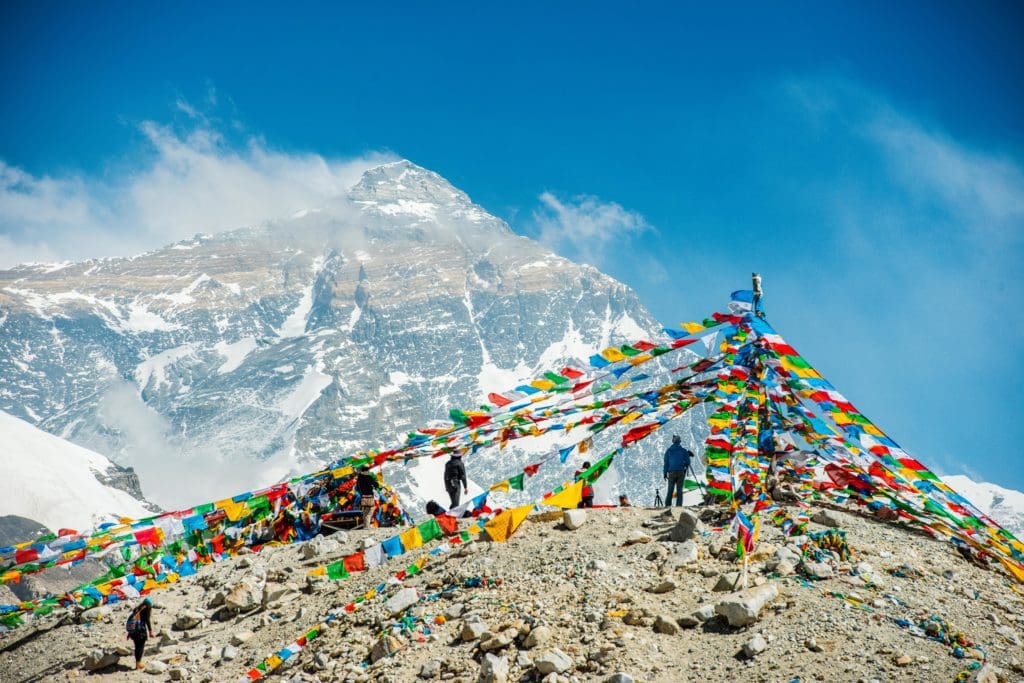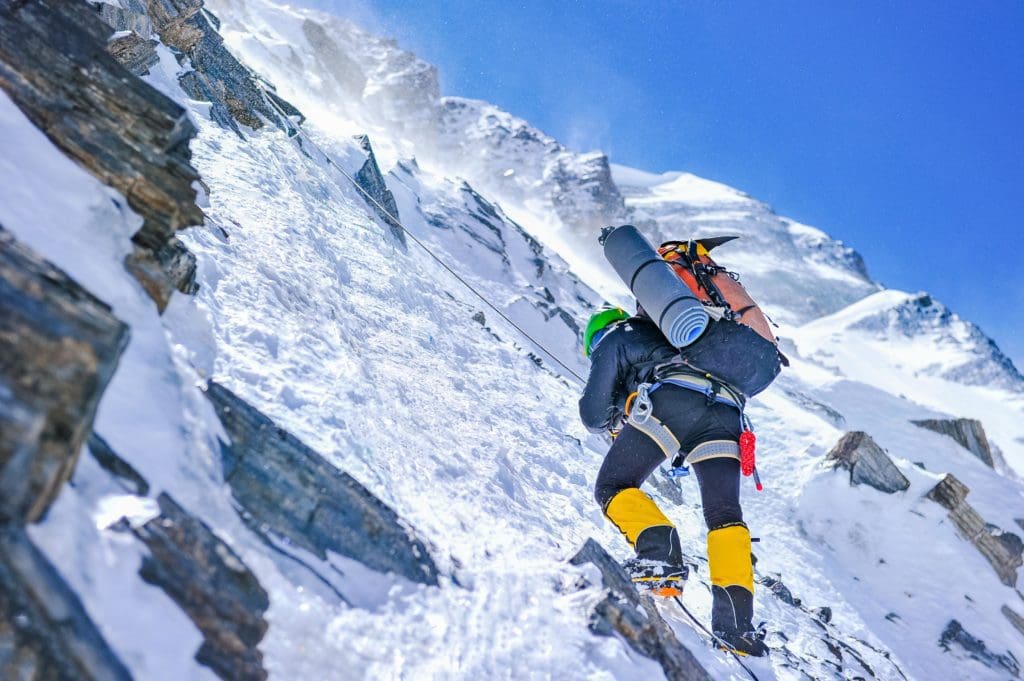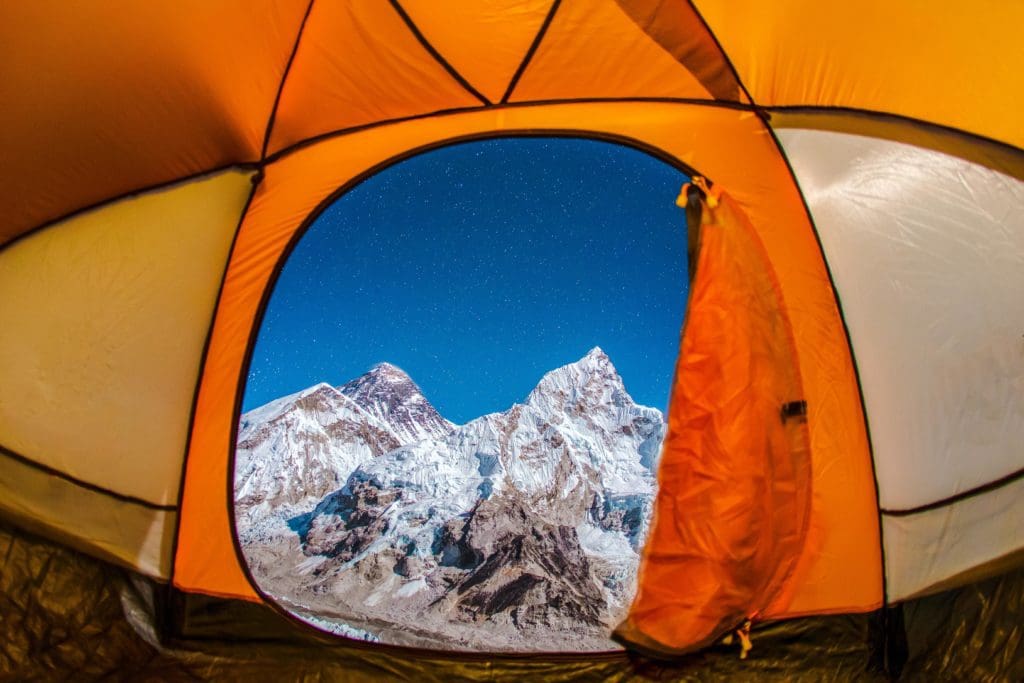|
Getting your Trinity Audio player ready...
|
Cory Richards has been walking a tightrope all his life, hovering between the physical dangers of death-defying mountain climbs and the inner demons of his own psyche. A self-described storyteller, explorer and photographer, he was climbing Gasherbrum II in Pakistan when he and his party were caught in a sudden avalanche that nearly killed them all. The horrifying footage that he captured during that disaster put him on the map professionally, but at a terrible cost. A life-long sufferer of both clinical depression and bipolarism, the aftermaths of the near-death experience left him with PTSD as well, and so just as his career really started to launch, his personal life became completely unraveled.
The film series, The Line, brilliantly explores boundaries we humans all face, using the quest to discover a new route up Mount Everest as a metaphor. The proposed new route is a nearly straight vertical path up an enormous and barren mountain face, while the personal lines Cory needs to tread are many and not so straight. The most obvious line anyone has to walk is simply the one between life and death, and this one is ever-present in the series. Near the end of the 11-month training regime, he admits, “I think about dying every day at this point.” It may sound like hyperbole, but after experiencing a few moments of the stark, unforgiving vistas of Everest, the viewer feels right there with him. In fact, that seems like the most likely line to be crossed.
The theme of the various difficult lines continues throughout the seven-film series, of what Cory must face both inside and outside. Calm/panic. Success/failure. Summit/not summit. Safe/dangerous. Wise/unwise. Cory asks himself, justifiably, “Am I insane? Or is this the most sane decision I’ve ever made?” Some people might say the jury is still out on whether climbers like him can possibly be considered sane, especially a man like Cory who has to carry so much personal baggage along with everything else. But the series slowly unravels the mysteries of “why,” through some difficult yet revealing interludes with Cory alone, juxtaposed with the incredible scenes of the Himalayas, beautifully captured again and again by the incredibly talented film crew.
The viewer is introduced to Cory as he explains that he is a man with very “simple” goals: 1) Climb an 8,000-meter peak in winter; 2) Climb Mount Everest without supplemental oxygen; and 3) Climb a completely new route on an 8,000-meter peak. Impressively, he has already done the first two, and so he calls this video series the “third installment” of meeting his life goals. In his life, Mount Everest acts as a magnet of sorts – he’s already spent seven seasons on and around it, actually climbing on it three times. This untried new route, “the line” if you will, obviously looms large in his head. Detailed photos of it make up the desktop screen on his computer. And the risks, of course, are obvious. “I’ve had a lot of success and a lot of failure in the mountains … I know nothing is ever guaranteed.” The slightest mishap, such as twisting an ankle or even dropping a glove, could suddenly end the attempt. But alongside the fear and anxieties, there is a lot of confidence as well, born of experience. “If we get the weather window, we’ll do it,” he vows.

Spectacular mountain scenery at Mount Everest Base Camp trek in Nepal.
Cory made it to the top of Mount Everest in 2016, an amazing triumph, “and yet it was the exact time that my life completely fell apart.” A divorce plus continued struggles with PTSD and alcoholism led him quickly to a personal rock bottom. He explains that “negative experiences lead to coping mechanisms.” And so he does everything in his power to be valued, to achieve some sort of external validation that he desperately needs to keep his head above water. “Yet at the same time, because I don’t believe I’m valuable, I start to destroy myself.” He feels that most of his life has been spent in those dichotomies, trying to successfully walk that line. For whatever reason, Mount Everest seems to personify his internal challenges. About returning to the mountain, he gets constantly asked why – you’ve already done it, why go back? “Everest is literally the place from where all else flows … where every single thing comes together.” It is a very personal place.
“Dreams can turn into goals. That’s when it becomes a reality.”
It’s not just attempting the mountain that is difficult. The lengthy training process has tremendous emotional ups and downs as well. There is the sheer physical toll of it all, not to mention the mental stamina needed to keep pushing through new barriers month after month. On top of all that, Cory does not consider himself to be a particularly strong individual. His mother took him to a psychologist at the age of one, out of her conviction that he was constantly depressed, “that things weren’t joyful for him.” She received no help at that point, but it turns out she was on the right track. Cory was diagnosed with major depression at 12 and also bipolar. His inner turmoils continue to be a struggle every day, and he also has to battle the stigmas people seem to have about them. He believes mental health issues are far more prevalent than people want to admit, and rather than be shamefully hidden away, they should be addressed matter-of-factly like anything else that needs treatment. “It’s not a weakness – in fact, in many ways, it can be a profound strength and a profound source of inspiration. It is absolutely just another piece of life.” And so, he feels that even if it’s uncomfortable to talk about or dwell on, if discussing his own struggles can help even one other person, then it’s worth doing.
Finally, the day of departure arrives, April 10, 2019. Naturally, an unexpected severe weather warning has all the flights delayed or canceled, a subtle reminder of how impactful winter weather can be, even when one is still safely on the ground at home. Eventually, Cory and Esteban “Topo” Mena, his climbing partner who is quite an experienced climber himself, arrive at the Denver airport. Topo was the youngest non-Sherpa climber to summit Mount Everest without using supplemental oxygen. He too sometimes asks himself about the “why.” “Why? I’m afraid of dying, I’m afraid of falling, it’s cold and harsh … but the mountain is just attracting me.” For some people, the “why” can be as simple as that.
Despite the weather delays and usual travel issues, Cory and Topo eventually arrive in Lhasa, the capital of Tibet. According to experienced climbers, a trip can only be said to truly start when you step off the plane into Lhasa. The film series helps the viewer in this regard, including captivating scenes from Lhasa itself, with the towering mountains ever-present in the distance in all directions. The visuals of Mount Everest from the air are extraordinary and awe-inspiring. “Seeing Everest, you understand how massive the goal really is.” And there looms the goal, their physical line, heading directly up the center of a prominent high face.
Nerves are beginning to show, with the end of a year’s worth of prep so near, yet the entire issue of success or failure is no closer to resolution. In a way, climbers feel that their whole lives have led up to a particular point – the beginning of their next climb. One might wonder if Cory’s life has honestly given him the necessary foundation for something so momentous. He was a troubled youth, moving out of his house at 15 and becoming homeless, bouncing around between friends’ couches as well as a few aunts and uncles. He was estranged from his brother after a series of nasty physical altercations, plus there is a long history of depression and addiction on both sides of the family. Finally reaching the end of his tether, he himself asked for professional psychiatric help at the age of 17. Exploration turned out to be a necessary cathartic for Cory, and he began to have some real successes. For example, he became the first American to conquer an 8,000-meter peak in wintertime. But just as his life was turning around, there came the terrible and near-fatal avalanche on G-2, with its concomitant PTSD. In spite of it all, however, Cory sees the silver lining, “I would’ve struggled with depression and alcoholism regardless, but that avalanche was the biggest gift I’ve ever been given – professionally, personally, emotionally, physically. Because it pushed me into a place of such utter … darkness that I was either going to kill myself, or I had to evolve.”

Climbing Mount Everest, Nepal
Now there is a completely new challenge ahead, the untried route up Everest. Cory and Topo spend a few nights at Base Camp, slowly acclimatizing for the difficult trek to come. They say that every time they come back to Base Camp, it’s like a family reunion because so many people know each other there. Advanced Base Camp (ABC) is another 10 miles in, including a pickup in elevation of 4,000 more feet. The film captures the amazing journey to Advanced Base Camp, featuring miles of gigantic ice sentinels silently guarding an enormous ageless mountain path. Around a bend is the first glimpse of the hoped-for new route, and it is “jaw-dropping.” Understandably, nerves continue to be a mounting issue as they inch closer and closer to their treacherous finale. “The power in all of this for me is stepping through that – stepping through the anxiety, stepping through the depression, stepping through all the history, stepping through all the fear … and stepping out onto a plane that is beyond that. That’s where the magic is for me.” Crossing the line to a better place.
Cory and Topo need to explore the first thousand meters beyond ABC to check out the conditions and discover what they are in for. Their path leads them higher and higher up a steep, stark ice cliff, and the video footage of this part of the journey is extraordinary, the closest one can feel to being on Everest besides actually being there oneself. As they continue up, the ice they are clinging to eventually changes to more of a snowpack that the climbers don’t approve of, referring to it as “spooky snow.” Then strange, strong winds rise up, blocking further process. The film makes great use of time-lapse so that it is easy to follow the source and direction of the swirling gusts roaring over the ant-like images of the two lonely climbers. The heightened winds finally put a stop to their progress for the day, and so, they painstakingly retrace their steps back to Advanced Base Camp, where they spend their time pouring over weather reports and forecasts on their laptops. After an impatient day or two, they see an indication of a possible 24-hour break in the wind, which will be their one window through which to attempt the summit.
evoTrip Trekking Trip Packages
There’s no better way to get to know a destination than getting on the trails and exploring. evoTrip trekking trip packages deliver hand-crafted hiking and trekking itineraries to some of the most breathtaking destinations around the globe. With evo’s partners and trips, you can forget about logistics and be fully present in your travel experience. So make your dream trip a reality and discover the epic trekking trips and destinations evo has to offer.
Explore evoTrip Trekking Destinations & Trips
May 21, 2019 is their personal D-Day when they face the line between success and failure. Oddly, failure is not delineated by making the summit or not. Topo spells it out, “Success is not dying up there. Period.” A person like Cory, of course, has a more nuanced understanding of success, and it comes in tiers. “1) Don’t die, and we don’t lose fingers or toes, success. 2) We come home [still] friends but didn’t go to the top, but still gave it our best shot, success. 3) We go to the top, friends, no death, mega success.” Obviously, both want the attempt to go well, but in these unbelievably harsh and dangerous conditions, survival mode takes precedence, so success has to be relative.
However, scared or not, their small window of opportunity has opened, and so the two set out, literally in the middle of the night. The dark visuals are simply stunning, with the peaks and valleys completely different creatures at night under the bright starlight. Finally, the slow dawn gives way to crystal-clear sunlight, finding them back on the sheer ice face, heading up. The video is spine-tingling, watching their torturous and methodical assent. “If any of that ice gives way, you’re on a 3,000-foot slip and slide. One mistake – if you’re not perfect – you die.”
At the halfway point, the mountain presents them with an unexpected choice – another line to guess. Left or right? This was unforeseen – from far below, it seemed like a straight line up. But now, 7,300 meters up on the Northeast face of Mount Everest, they have an unexpected choice to make. After some time, they chose left, which seemed like the slightly easier path to take. But it turned out to be snowier, and they found themselves endlessly trail-breaking on the exposed face. After a brutal 12-hour day of nonstop climbing, they had to take a break and attempt to overnight on the spot. Spirits and energy were at a low, not to mention body temperature. The climbing was much more arduous than they had guessed. Yet, the eventual dawn brought new hope, and they found they still had both the energy and the will to continue, even as the wind slowly rose to greet them. After experiencing all this, viewers feel like they actually know a small part of Mount Everest personally.

View of the Himalayan landscape including Mountains Everest, Lhotse and Nuptse.
“Going to the mountains gives you some kind of clarity because you’re confronted with your own mortality.” Cory grows philosophical as his limits are reached, then stretched. Remembering his personal demons, the viewer understands the next point, “Being in the mountains gives some semblance of balance in my life.” Another line, another balancing act. In a characteristic gesture, Cory ticks off these points on his fingers as he explains the rationale of his even being there in the first place. “As much as it’s about climbing a line up a mountain, it’s about walking a line in life that has value, that provides me with a sense of purpose, gives me hope, and ultimately helps me err on the side of sanity.”
The Line is an epic tale of personal resilience and fortitude, lapses and downfalls, physical hardship and determination. In short, it’s a tale about life itself writ large upon the giant shoulders of Mount Everest. Whether one views the series as a documentary about professional mountain-climbing or a detailed commentary on the human condition, it is a story well worth experiencing and considering.
After surviving an avalanche in 2011, photographer Cory Richard’s world began to fall apart. Suffering from post-traumatic stress disorder, he found that the only escape from the struggles of daily life was the adrenaline rush of a good adventure. Watch the following video to learn more about Cory’s story:
About Cory Richards
Cory Richards is an American alpinist and visual storyteller who mainly works for National Geographic. He is a rule breaker who kept pushing boundaries from running away from rehab to venturing through unclimbed peaks from Antarctica to the Himalayas of Nepal and Pakistan. He dedicates himself to “translate that experience for people through imagery”. He captures the inherent beauty of today’s world.
Global Rescue Membership
Skyblue Overland has been working with Global Rescue to spread awareness of their membership perks. Medical and security emergencies happen. When you find yourself in a tough position and are in need of some serious medical or rescue help, you want someone like Global Rescue to call. If you do not have a membership with someone like Global Rescue, an emergency evacuation could cost up to $100,000. That is why over 1 million members globally trust Global Rescue to get them out of those frightening situations.
Popular Articles:
Adventure Storytelling: Developing A Visual Story That Connects
ROAM Media Unveils New Academy Classes For Adventurers
ROAM Towards A Life Of Adventure and Purpose
ROAM Academy: Learn Climbing Skills With The Mountain Curriculum
ROAM Academy: Mind Body Prep For Adventure With Pro Skier Lynsey Dyer










